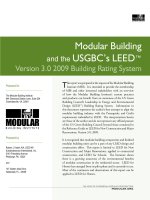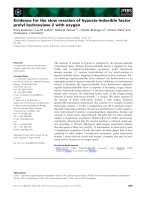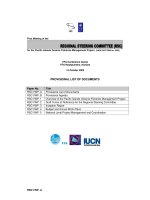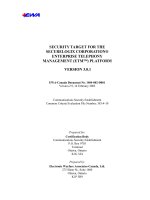SECURITY TARGET FOR THE SECURELOGIX CORPORATION® ENTERPRISE TELEPHONY MANAGEMENT (ETM™) PLATFORM VERSION 3.0.1 pptx
Bạn đang xem bản rút gọn của tài liệu. Xem và tải ngay bản đầy đủ của tài liệu tại đây (411.6 KB, 68 trang )
SECURITY TARGET FOR THE
SECURELOGIX CORPORATION®
ENTERPRISE TELEPHONY
MANAGEMENT (ETM™) PLATFORM
VERSION 3.0.1
EWA-Canada Document No. 1404-002-D001
Version 2.9, 14 February 2002
Communications Security Establishment
Common Criteria Evaluation File Number: 383-4-10
Prepared for:
Certification Body
Communications Security Establishment
P.O. Box 9703
Terminal
Ottawa, Ontario
K1G 3Z4
Prepared by:
Electronic Warfare Associates-Canada, Ltd.
275 Slater St., Suite 1600
Ottawa, Ontario
K1P 5H9
SECURITY TARGET FOR THE SECURELOGIX CORPORATION®
ENTERPRISE TELEPHONY MANAGEMENT (ETM™) PLATFORM
VERSION
3.0.1
Document No. 1404-002-D001
Version 2.9, 14 February 2002
<Original> Approved by:
Project Engineer:
Project Manager:
Program Director:
(Signature) (Date)
ETM™ Platform v3.0.1 Security Target
Doc No: 1404-002-D001 Version: 2.9 Date: 14 Feb 02 Page i of ii
TABLE OF CONTENTS
1 INTRODUCTION 1
1.1 Identification 1
1.2 Overview 1
1.3 CC Conformance 3
2 TARGET OF EVALUATION DESCRIPTION 4
3 TOE SECURITY ENVIRONMENT 8
3.1 Assumptions 8
3.2 Threats 8
3.2.1 Threats Addressed By The TOE 8
3.2.2 Threats To Be Addressed By Operating Environment 9
4 SECURITY OBJECTIVES 11
4.1 TOE Security Objectives 11
4.2 Environment Security Objectives 12
5 IT SECURITY REQUIREMENTS 13
5.1 TOE Security Requirements 13
5.1.1 TOE Security Functional Requirements 13
5.1.2 TOE Security Assurance Requirements 26
6 TOE SUMMARY SPECIFICATION 38
6.1 TOE Security Functions 38
6.2 Assurance Measures 42
7 PROTECTION PROFILE CLAIMS 44
8 RATIONALE 45
8.1 Security Objectives Rationale 45
8.1.1 TOE Security Objectives Rationale 45
8.1.2 Environment Security Objectives Rationale 48
8.2 Security Requirements Rationale 49
8.2.1 Security Functional Requirements Rationale 49
8.2.2 Assurance Requirements Rationale 52
8.2.3 Rationale for Satisfying Functional Requirement Dependencies 52
8.2.4 Rationale for Satisfying Assurance Requirement Dependencies 54
8.2.5 Rationale for Security Functional Refinements 54
8.2.6 Rationale for Audit Exclusions 56
ETM™ Platform v3.0.1 Security Target
Doc No: 1404-002-D001 Version: 2.9 Date: 14 Feb 02 Page ii of ii
8.3 TOE SUMMARY SPECIFICATION RATIONALE 56
8.3.1 TOE Security Functions Rationale 56
8.3.2 TOE Assurance Measures Rationale 61
9 ACRONYMS AND ABBREVIATIONS 64
LIST OF FIGURES
Figure 1: Example ETM™ Platform Configuration 2
Figure 2: TOE Boundary Diagram 5
LIST OF TABLES
Table 1 Summary of Security Functional Requirements 13
Table 2 Additional Auditable Events from CC Functional Components 15
Table 3 Assurance Requirements for ETM™ Platform 26
Table 4 Mapping of TOE Security Objective to Threats 45
Table 5 Mapping of Environment Security Objectives to Threats and Assumptions 48
Table 6 Mapping of Security Functional Requirements to IT Security Objectives 49
Table 7 Security Functional Requirement Dependencies 53
Table 8 Assurance Requirement Dependancies 54
Table 9 Rationale for Audit Exclusions 56
Table 10 Mapping of Security Functions to Security Functional Requirements 57
Table 11 Mapping of Assurance Measures to Assurance Requirements 61
ETM™ Platform v3.0.1 Security Target
Doc No: 1404-002-D001 Version: 2.9 Date: 14 Feb 02 Page 1 of 64
1 INTRODUCTION
1.1 IDENTIFICATION
This document details the Security Target (ST) for the SecureLogix Corporation® ETM™
Platform. This ST has been prepared
1
in accordance with the Common Criteria for
Information Technology Security Evaluation (CC), version 2.1, August 1999.
1.2 OVERVIEW
The ETM™ Platform is designed to protect telecommunications lines from abuse, and
provide extensive auditing capabilities on all telecommunications line traffic. The system
can operate in conjunction with a private branch exchange (PBX), but it is not required. The
ETM™ Platform components are:
a. the ETM™ Management Server version 3.0.1 running on an Intel based PC
with Windows NT 4 as the operating system (also available for Solaris and
Windows 2000 platforms);
b. the administrator TeleView™ Console version 3.0.1 running on an Intel based
PC with Windows NT, Windows 98, Windows 2000 or on a Solaris based
platform;
c. hardware analog appliances;
d. hardware T1 appliances;
e. hardware ISDN/PRI appliances; and
f. hardware E1 ISDN/PRI appliances.
The ETM™ Management Server and TeleView™ Console are both written in the Java
programming language and require a Java Virtual Machine to be installed on their host PC.
All appliances are designed by SecureLogix Corporation® using commercially available
components, and use the LINUX
2
2.4 kernel as the underlying operating system.
The ETM™ Platform mediates access between local telecommunication users and external
telecommunication users based on rules defined by the administrator. Rulesets are created on
the ETM™ Management Server which are then pushed down to the appliances. The
appliances allow or deny calls based on their respective rulesets. The default behaviour is to
allow any calls not explicitly denied.
A hardware setting exists, for all 1000 series appliances, to determine the default behaviour
should a ETM™ Platform appliance fail (due to a power outage for example). ETM™
Platform appliances can be configured to fail-safe (allow all calls), or fail-secure (deny all
calls including emergency numbers).
1
The ST author is Kim Frawley Braun of EWA-Canada.
2
A stripped down version of Linux is used. There is no ftpd, inetd or login prompt.
ETM™ Platform v3.0.1 Security Target
Doc No: 1404-002-D001 Version: 2.9 Date: 14 Feb 02 Page 2 of 64
Ethernet network links are used to facilitate the following communication channels:
a. between the appliances and ETM™ Management Server;
b. between the TeleView™ Console and ETM™ Management Server; and
c. between the administrator and appliances (Telnet).
ETM™ Platform includes an option to encrypt network communications using DES (by
default) and Triple DES (upon request) cryptography. Administrators may also communicate
directly with the appliances though a serial port located on the appliances.
Modem
PBX
Telephone
Telecommunication Lines
Network Link
CO
Analog Appliance
ISDN/PRI Appliance
T1 Appliance
Hub
Fax
TeleView
TM
Console
ETM™Management Server
& TeleView
TM
Console
E1 Appliance
Figure 1: Example ETM™ Platform Configuration
The ETM™ Platform human machine interface (HMI) allows the administrator to perform
the following functions:
a. specify rules governing how telecommunication access is mediated;
b. specify the level of network activity displayed; and
c. specify what telecommunication activity is logged.
ETM™ Platform v3.0.1 Security Target
Doc No: 1404-002-D001 Version: 2.9 Date: 14 Feb 02 Page 3 of 64
The HMI also provides the user with current and historical views of individual calls, and
their associated level of activity. Extensive report and graphs may be generated from the
historical data.
Appropriate security measures are expected to exist for the network on which the ETM™
Platform is deployed to protect the communications between components. Appropriate
mechanisms must be put in place on the commercial products being used that are external to
any SecureLogix components. The ETM™ Platform can be configured to encrypt
communications between its components. The Target of Evaluation (TOE) consists of the
ETM™ Management Server, the TeleView™ Console, and the four types of appliances
(analog, T1, ISDN/PRI, E1 ISDN/PRI).
1.3 CC CONFORMANCE
The ETM™ Platform is conformant with the functional requirements specified in Part 2 of
the CC. The ETM™ Platform is conformant to the assurance requirements for Evaluation
Assurance Level (EAL) 2, as specified in Part 3, of the CC, with the following
augmentations:
a. ACM_CAP.3 – Authorisation controls;
b. ACM_SCP.1 – TOE CM coverage; and
c. ALC_DVS.1 – Identification of security measures.
ETM™ Platform v3.0.1 Security Target
Doc No: 1404-002-D001 Version: 2.9 Date: 14 Feb 02 Page 4 of 64
2 TARGET OF EVALUATION DESCRIPTION
The ETM™ Platform is designed to protect telecommunications lines from abuse, and
provide extensive auditing capabilities on all telecommunications line traffic
3
. The system
can operate in conjunction with a private branch exchange (PBX), but it is not required. The
evaluated configuration consists of:
a. the ETM™ Management Server version 3.0.1 executing on an Intel based PC
with Windows NT 4 SP6a, Windows 2000 and Solaris 7/8 as the operating
systems;
b. the administrator TeleView™ Console version 3.0.1 executing on an Intel
based PC with Windows NT 4 SP6a, and Windows 98 (unpatched), Windows
2000 and Solaris as the operating systems;
c. Java Virtual Machine software, version 1.3.1 on both the ETM™
Management Server and TeleView™ Console hosts;
d. hardware analog appliances software version 3.0.30, hardware Model ETM™
1010;
e. hardware T1 appliances software version 3.0.30, hardware Model ETM™
1020, Model ETM™ 2100 or Model ETM™ 3200;
f. hardware ISDN-PRI appliances software version 3.0.30, hardware Model
ETM™ 1030, Model ETM™ 2100 or Model ETM™ 3200; and
g. hardware E1 ISDN-PRI appliances software version 3.0.30, hardware Model
ETM™ 1040, Model ETM™ 2100 or Model ETM™ 3200.
The minimum hardware requirements for the ETM™ Management Server and TeleView™
Console are specified in the ETM™ Platform Installation and Configuration Guide provided
as part of the ETM™ 3.0.1 Product Code CD.
The ETM™ Platform components (appliances, ETM™ Management Server, TeleView™
Console) can be distributed across an Ethernet network. The network access security policy
requires administrators
4
to provide a valid username and password for authentication.
Appliances maintain a file of “allowed” IP addresses and only allow communications from
ETM™ Management Servers which have an IP address in the file. ETM™ Management
Servers have a similar file for communications to remote TeleView™ Consoles.
The administrator uses the TeleView™ Console to communicate to ETM™ Management
Server, and through it, communicate with the appliances. The administrator may also
directly communicate to the appliances through a Telnet server or a serial port on the
appliances. The Telnet access to a appliance can be disabled if desired, and will also be
3
The TOE protects the telecommunications lines, but uses a TCP/IP network for internal communications. The
use of the term “network” refers only to the TCP/IP network, not the telecommunications lines.
4
The term “administrator” refers only to individuals who communicate over the network to configure and
operate EMT™ Platform.
ETM™ Platform v3.0.1 Security Target
Doc No: 1404-002-D001 Version: 2.9 Date: 14 Feb 02 Page 5 of 64
disabled automatically for a period of one hour, by the appliance, if there are six failed
logins. The failed login count resets to zero after a successful login.
The system can encrypt communications between components using DES or Triple DES
cryptography. The DES and Triple DES algorithms (cryptographic module identifier – NIST
validated implementation version 3) have been evaluated and approved to the FIPS 46-3 DES
and FIPS 81 DES Modes of Operation standards.
Modem
PBX
Telephone
Telecommunication Lines
Network Link
CO
Analog Appliance
ISDN/PRI Appliance
T1 Appliance
Hub
TOE Boundary
TeleView
TM
Console
ETM™Management Server
& TeleView
TM
Console
Fax
E1 Appliance
Figure 2: TOE Boundary Diagram
The appliances control and enforce the information flow security policy on the
telecommunication lines based on the ruleset and configurations downloaded from the
ETM™ Management Server. The appliances can be configured individually, or as a group.
There are four appliance types corresponding to different types of telecommunications lines:
analog, T1, ISDN/PRI and E1 ISDN/PRI. All four appliances were created by SecureLogix
Corporation® using commercially available hardware components and execute on the
LINUX operating system. SecureLogix Corporation® has added an extensive set of
appliance command line instructions called ETM commands. The ETM command set can be
ETM™ Platform v3.0.1 Security Target
Doc No: 1404-002-D001 Version: 2.9 Date: 14 Feb 02 Page 6 of 64
accessed through a Telnet connection, command line window opened in the TeleView™
Console, or serial link, however a small subset of the ETM commands can only be performed
locally at the appliance through the serial link. Each appliance type is included in the
ETM™ Platform evaluation.
The TeleView™ Console allows the administrator to manage one or multiple ETM™
Platforms using graphical windows. The administrator can configure appliances by creating
a configuration file on the ETM™ Management Server, which gets pushed down to the
appliances. Checks are performed on a regular basis to ensure the appliances are executing
the latest configuration file as defined (stored) on the ETM™ Management Server. It is
important to note that any changes to the appliance configurations should be made through
the TeleView™ Console (where possible), otherwise, changes made by communicating
directly to the appliances can be overwritten when the next check occurs (the configuration
file on the appliance would be different than that on the ETM™ Management Server so
would be changed to match the ETM™ Management Server).
The default telecommunications information flow security policy for ETM™ Platform
telecommunications users is “telecommunications that are not explicitly denied, are
allowed”. The ruleset is traversed from top to bottom, triggering on the first applicable rule.
A default rule exists at the top of the ruleset to always allow emergency calls (e.g. 911). The
default rule cannot be removed. Administrators can create rules based on: calling number;
called number; call type (voice, fax, modem, STU III, busy, unanswered, wide-band and
undetermined), call direction (inbound, outbound), time of day, and call duration. ETM™
Platform includes the ability to examine the ruleset for ambiguous rules (e.g. rules that will
never get triggered due to a previous rule).
ETM™ Platform has extensive auditing and reporting capabilities. The levels of events to be
audited can be set by the administrator. Each audit record contains a unique identification
number, date and time stamps, and the appliance or appliance array which originated the
record. All call details (numbers, times, telecommunication line specifics, etc.) are recorded
and can be viewed in a generated report (from canned or created templates) or plotted in a
graph through the TeleView™ Console.
Most of the data produced during the operation of the ETM™ Platform is stored in the
ETM™ Database, which is part of the ETM™ Management Server. The ETM™ RDBMS
supports Oracle DBMS. The DBMS used for the ETM™ Database can be installed on the
same computer as an ETM™ Management Server, or on a remote computer.
Audit records concerning telecommunication information flow and appliance status are
generated at the appliances. The audit data is then uploaded to the ETM™ Management
Server. Each appliance contains a memory card, which can store the audit records
temporarily if the ETM™ Management Server is unavailable. The memory cards can hold
the audit data in a circular buffer where they will eventually get overwritten with newer
ETM™ Platform v3.0.1 Security Target
Doc No: 1404-002-D001 Version: 2.9 Date: 14 Feb 02 Page 7 of 64
records, however there is sufficient memory to hold multiple days of audit logs even under
heavy telecommunications traffic.
ETM™ Platform v3.0.1 Security Target
Doc No: 1404-002-D001 Version: 2.9 Date: 14 Feb 02 Page 8 of 64
3 TOE SECURITY ENVIRONMENT
3.1 ASSUMPTIONS
The following conditions are assumed to exist in the operational environment:
Application Note: The TOE protects the telecommunications lines, but uses a TCP/IP
network for internal communications. The use of the term “network” refers only to the
TCP/IP network, not the telecommunications lines. The term “telecommunications user”
refers only to individuals or IT entities that communicate over the telecommunications lines.
The term “network attacker” refers only to individuals or IT entities that communicate over
the network. As security functional refinement and unless stated otherwise in this ST, the
term “user” is meant to be administrator(s) who communicate over the network to configure
and operate the ETM™ Platform.
A.PHYSEC The TOE is physically secure.
A.PRONET Network protection mechanisms are in place for the server and TeleView™
Console client.
A.NOEVIL Administrators are non-hostile and follow all administrator guidance;
however, they are capable of error.
A.ADMKNW The administrator is knowledgeable of TCP/IP networking and
Telecommunication systems.
3.2 THREATS
The following threats are addressed either by the TOE or the environment.
3.2.1 Threats Addressed By The TOE
The threats discussed below are addressed by a compliant TOE. The threat agents are either
human users or external IT entities not authorised to use the TOE. The assets that are subject
to attack are telecommunications resources.
T.SNIFF A network attacker may observe authentication data or system configuration
info as it is transmitted between portions of the TOE.
T.REPLAY A network attacker may use previously captured or falsified data to
authenticate to the TOE or alter its configuration.
ETM™ Platform v3.0.1 Security Target
Doc No: 1404-002-D001 Version: 2.9 Date: 14 Feb 02 Page 9 of 64
T.ATKNET A network attacker may attack the TOE appliances.
T.INTRES An unauthorised external telecommunications user may gain access to internal
telecommunication resources (telephones, modems, faxes, etc.).
T.EXTRES An internal telecommunications user may gain unauthorised access to external
telecommunications resources (telephones, modems, faxes, etc.).
T.MISUSE A telecommunications user may use internal telecommunications resources in
an unauthorised manner (make a voice call on a fax line, etc.).
T.TOEPRO A telecommunications user may bypass, deactivate, corrupt or tamper with
TOE security functions.
T.ATKVIS A telecommunications user may conduct undetected attack attempts against
the TOE.
T.TOEDAT A telecommunications user may read, modify or destroy TOE internal data.
T.TOEFCN A telecommunications user may access and use security and/or non-security
functions of the TOE.
T.NONAPP An administrator may be unaware that an unauthorised application, executing
on the TOE, is accessing the telecommunications lines or network via TOE
interfaces.
T.NOCOM An administrator may be unaware that TOE internal communications have
failed.
T.AUDEXH An administrator may be unaware that the audit storage of the TOE has been
exhausted.
3.2.2 Threats To Be Addressed By Operating Environment
The threat possibilities discussed below must be countered by procedural measures and/or
administrative methods. The threat agents are either human users or external IT entities not
authorised to use the TOE. The assets that are subject to attack are telecommunications
resources.
T.USAGE The TOE may be configured, used and administered in an insecure manner
unwittingly by the user.
T.BADADM Compromise of the integrity and/or availability of the TOE may occur as a
result of an administrator not following proper security procedures.
ETM™ Platform v3.0.1 Security Target
Doc No: 1404-002-D001 Version: 2.9 Date: 14 Feb 02 Page 10 of 64
T.TROJAN Compromise of the integrity and/or availability of the TOE may occur as a
result of an administrator unwittingly introducing a virus or trojan into the
system.
ETM™ Platform v3.0.1 Security Target
Doc No: 1404-002-D001 Version: 2.9 Date: 14 Feb 02 Page 11 of 64
4 SECURITY OBJECTIVES
4.1 TOE SECURITY OBJECTIVES
The following are the IT security objectives for the TOE:
O.CRYPTO The TOE must protect the confidentiality of authentication and system
configuration data using cryptography as it passes between distributed
components of the TOE.
O.ATKNET The TOE appliances must protect themselves against attack from the network.
Replay attacks, in appliance to server communications, are countered by the
communications being authenticated with a variable handshake and encrypted
with valid cryptokey/algorithm.
O.MEDTEL The TOE must mediate telecommunications access both inbound and
outbound on the telecommunications lines. The TOE shall be capable of
allowing or denying the communication based on predefined attributes.
O.TELTOE The TOE should not allow access to the TOE from the telecommunications
interfaces.
O.COMM The TOE must provide a mechanism to handle internal communication
failures.
O.AUDCHK The TOE must provide a mechanism that advises the administrator when local
audit storage has been exhausted.
O.ADMACC An administer role will exist on the TOE with access control mechanisms
such that only authenticated administrators are able to perform security
relevant functions.
O.HMI The TOE must provide functionality that enables an administrator to
effectively manage the TOE and its security functions from its local HMI.
O.DSPACT The TOE must display to the user the current and recent history of
telecommunications activity associated with the telecommunication lines.
O.AUDIT The TOE must record and store a readable audit trail of TOE
telecommunications activity and security relevant events, and permit their
review only by authorised administrators. The TOE will be capable of
performing audit reduction, and of triggering alarms as required by the
administrator.
ETM™ Platform v3.0.1 Security Target
Doc No: 1404-002-D001 Version: 2.9 Date: 14 Feb 02 Page 12 of 64
O.SELFPRO The TOE must protect itself against attempts by a telecommunications user
from the telecommunications side to bypass, deactivate, corrupt or tamper
with TOE security functions.
4.2 ENVIRONMENT SECURITY OBJECTIVES
The following are non-IT security objectives that are to be satisfied without imposing
technical requirements on the TOE. That is, they will not require the implementation of
functions in the TOE hardware and/or software. Thus, they will be satisfied largely through
application of procedural or administrative measures.
O.NETPRO The organisation responsible for the server and TeleView™ Console client
portions of the TOE must ensure to their satisfaction that these components
are protected against network attacks.
O.GUIDAN The administrator responsible for the TOE must ensure that the TOE is
delivered, installed, configured, administered, and operated in a manner that
maintains its security.
O.AUTHUSR Only authorised administrators are permitted physical access to the TOE.
ETM™ Platform v3.0.1 Security Target
Doc No: 1404-002-D001 Version: 2.9 Date: 14 Feb 02 Page 13 of 64
5 IT SECURITY REQUIREMENTS
5.1 TOE SECURITY REQUIREMENTS
This section provides functional and assurance requirements that must be satisfied by a
compliant TOE. These requirements consist of functional components from Part 2 of the CC
and an Evaluation Assurance Level (EAL) containing assurance components from Part 3 of
the CC.
5.1.1 TOE Security Functional Requirements
The functional security requirements for this ST consist of the following components from
Part 2 of the CC, summarised in Table 1. All users of the TOE can be divided into three
distinct groups: administrators, telecommunication users and network attackers. The three
types are quite different in their interactions with the TOE. As such, access control for
administrators is addressed by FDP_ACC.1 (1), FDP_ACF.1 (1), FIA_ATD.1, FIA_SOS.1,
FIA_UAU.1, and FIA_UID.1, while telecommunications users are addressed by FDP_IFC.1
(1) and FDP_IFF.1 (1) and network attackers are addressed by FDP_IFC.1 (2) and
FDP_IFF.1 (2).
The TOE Security Policy (TSP) is comprised of the TELCO, FILE, and NETWORK
Security Function Policies (SFPs) that define the rules by which the TOE governs access to
its telecommunication, file, and network resources.
Table 1 Summary of Security Functional Requirements
Functional Components
Identifier Name
FAU_ARP.1 Security Alarms
FAU_GEN.1 Audit data generation
FAU_SAA.1 Potential violation analysis
FAU_SAR.1 Audit review
FAU_SAR.3 Selectable audit review
FAU_SEL.1 Selective audit
FAU_STG.1 Protected audit trail storage
FAU_STG.3 Action in case of possible audit data loss
FCS_COP.1 Cryptographic operation
FDP_ACC.1 (1) Subset access control
FDP_ACF.1 (1) Security attribute based access control
FDP_ACC.1 (2) Subset access control
FDP_ACF.1 (2) Security attribute based access control
FDP_IFC.1 (1) Subset information flow control
ETM™ Platform v3.0.1 Security Target
Doc No: 1404-002-D001 Version: 2.9 Date: 14 Feb 02 Page 14 of 64
Functional Components
Identifier Name
FDP_IFF.1 (1) Simple security attributes
FDP_IFC.1 (2) Subset information flow control
FDP_IFF.1 (2) Simple security attributes
FIA_AFL.1 Authentication failure handling
FIA_ATD.1 User attribute definition
FIA_SOS.1 Verification of secrets
FIA_UAU.1 Timing of authentication
FIA_UID.1 Timing of identification
FMT_MOF.1 Management of security functions behaviour
FMT_MSA.1 Management of security attributes
FMT_MSA.3 Static attribute initialisation
FMT_MTD.1 Management of TSF data
FMT_SMR.1 Security Roles
FPT_ITT.1 Basic internal TSF data transfer protection
FPT_STM.1 Reliable time stamps
FTP_TRP.1 Trusted Path
FAU_ARP.1 Security Alarms
FAU_ARP.1.1 – The TSF shall take [one or more of the following actions:
audible alarm, SNMP trap, email with or without attachments, pager,
TeleSweep Secure® scan, visual alert] upon detection of a potential security
violation.
FAU_GEN.1 Audit data generation
FAU_GEN.1.1 – The TSF shall be able to generate an audit record of the
following auditable events:
a. Start-up and shutdown of the audit functions;
b. All auditable events for the [basic] level of audit identified in Table 2
(Application Note: Basic level includes all minimum requirements as
well);
c. exhaustion of log storage;
d. changes in TOE security function configuration;
e. failed and successful logins by administrators to an appliance;
f. logins/logouts by administrators to ETM™ Management Server;
g. failed and successful logins by user to an appliance;
h. changes to rulesets that are applied to an appliance;
ETM™ Platform v3.0.1 Security Target
Doc No: 1404-002-D001 Version: 2.9 Date: 14 Feb 02 Page 15 of 64
i. the additions/deletions/clones/modifications an administrator performs
in the ETM™ Management Server;
j. appliance and telephone circuit errors;
k. requests from unknown appliances;
l. detection of an ambiguous rule; and
m. rule violations.
FAU_GEN.1.2 – The TSF shall record within each audit record at least the
following information:
a. Date and time of the event, type of event, subject identity (when
available), and the outcome (success or failure) of the event; and
b. For each audit event type, based on the auditable event definitions of
the functional components included in the ST:
· [call destination (called number);
· call source (calling number), if available;
· call trunk channel; call trunk group;
· call begin time;
· call end time;
· call type as fax, modem, voice, STU voice, STU data, STU
generic, unknown, busy, unanswered, wideband or undetermined;
· call direction as inbound or outbound;
· call duration;
· call “in-call” digits;
· call trailing digits;
· a unique identifying number for each entry;
· the appliance which originated the event; and
· the appliance array the appliance belongs to].
Table 2 Additional Auditable Events from CC Functional Components
Functional
Component
Level Auditable Event
FAU_ARP Minimum Actions taken due to imminent security violations.
Minimum Enabling and disabling of any of the analysis mechanisms.
FAU_SAA.1
Minimum Automated responses performed by the tool.
FAU_SAR.1 Basic Reading of information from the audit records.
FAU_SEL.1 Minimum
All modifications to the audit configuration that occur while
the audit collection functions are operating.
FAU_STG.3 Basic Actions taken due to exceeding of a threshold.
FCS_COP.1 Minimum Success and failure and the type of cryptographic operation.
ETM™ Platform v3.0.1 Security Target
Doc No: 1404-002-D001 Version: 2.9 Date: 14 Feb 02 Page 16 of 64
Functional
Component
Level Auditable Event
Basic
Any applicable cryptographic mode(s) of operation, subject
attributes and object attributes.
Minimum
Successful requests to perform an operation on an object
covered by the SFP.
FDP_ACF.1
Basic
All requests to perform an operation on an object covered by
the SFP.
Minimum Decisions to permit requested information flows.
FDP_IFF.1
Basic All decisions on requests for information flows.
FIA_AFL.1 Minimum
The reaching of the threshold for the unsuccessful
authentication attempts and the actions (e.g. disabling of a
terminal) taken and the subsequent, if appropriate, restoration
to the normal state (e.g. re-enabling of a terminal).
Minimum Rejection by the TSF of any tested secret.
FIA_SOS.1
Basic Rejection or acceptance by the TSF of any tested secret.
Minimum Unsuccessful use of the authentication mechanism.
FIA_UAU.1
Basic All use of the authentication mechanism.
Minimum
Unsuccessful use of the user identification mechanism,
including the user identity provided.
FIA_UID.1
Basic
All use of the user identification mechanism, including the
user identity provided.
FMT_MOF.1 Basic
All modifications in the behaviour of the functions in the
TSF.
FMT_MSA.1 Basic All modification of the values of security attributes.
Basic
Modifications of the default setting of permissive or
restrictive rules. FMT_MSA.3
Basic All modifications of the initial values of security attributes.
FMT_MTD.1 Basic All modifications to the values of TSF data.
FMT_SMR.1 Minimum Modifications to the group of users that are part of a role
FPT_STM.1 Minimum Changes to the time.
Minimum Failures of the trusted path functions.
Minimum
Identification of the user associated with all trusted path
failures if available.
Basic All attempted uses of the trusted path functions.
FTP_TRP.1
Basic
Identification of the user associated with all trusted path
invocations if available.
FAU_SAA.1 Potential violation analysis
ETM™ Platform v3.0.1 Security Target
Doc No: 1404-002-D001 Version: 2.9 Date: 14 Feb 02 Page 17 of 64
FAU_SAA.1.1 – The TSF shall be able to apply a set of rules in monitoring
the audited events, and based upon these rules indicate a potential violation of
the TSP.
FAU_SAA.1.2 – The TSF shall enforce the following rules for monitoring
audited events:
a. Accumulation or combination of [communication failure] known to
indicate a potential security violation;
b. [Administrator created rules set by configurable security policy,
dialing plan and call monitoring definition and based on calling
number, called number, call type (voice, fax, modem, STU voice, STU
data, STU generic, busy, unanswered, wideband, undetermined), call
direction (inbound, outbound), call duration, and time of day.]
FAU_SAR.1 Audit review
FAU_SAR.1.1 – The TSF shall provide [an administrator] with the capability
to read [all audit data] from the audit records.
FAU_SAR.1.2 –The TSF shall provide the audit records in a manner suitable
for the user to interpret the information.
FAU_SAR.3 Selectable audit review
FAU_SAR.3.1 – The TSF shall provide the ability to perform [searching and
ordering] of audit data based on:
a. [log time;
b. start time;
c. end time;
d. duration;
e. in/out call direction;
f. source;
g. destination;
h. type;
i. “in-call” digits;
j. trailing digits;
k. tracks;
l. appliance array;
m. appliance;
n. trunk group;
o. channel;
ETM™ Platform v3.0.1 Security Target
Doc No: 1404-002-D001 Version: 2.9 Date: 14 Feb 02 Page 18 of 64
p. name of ruleset;
q. rule number;
r. rule comment;
s. unique record ID;
t. unsuccessful login attempts; and
u. call information (LOC-local call, INTL-international call, VSC-
vertical service code, etc.) ].
The TSF shall provide the ability to perform [filtering] of audit data based on:
a. [date;
b. call direction;
c. call duration;
d. phone number;
e. call type;
f. “in-call” digits;
g. trailing digits;
h. track;
i. appliance array;
j. appliance;
k. text ; and
l. call information (LOC-local call, INTL-international call, VSC-
vertical service code, etc.)
Application Note: For the several of the searchable audit fields, there are sub-
types. The reporting tool included with ETM™ Platform allows filters to be
used to provide a finer layer of granularity. For example, if a user wished to
see audit records only for modems, the user would have to search based on
call type, leaving only modem records.
FAU_SEL.1 Selective audit
FAU_SEL.1.1 – The TSF shall be able to include or exclude auditable events
from the set of audited events based on the following attributes: [event type].
FAU_STG.1 Protected audit trail storage
FAU_STG.1.1 – The TSF shall protect the stored audit records from
unauthorised deletion.
FAU_STG.1.2 – The TSF shall be able to [prevent] modifications to the audit
records.
ETM™ Platform v3.0.1 Security Target
Doc No: 1404-002-D001 Version: 2.9 Date: 14 Feb 02 Page 19 of 64
Application Note: The audit protection mechanisms are provided by the
underlying database server.
FAU_STG.3 Action in case of possible audit data loss
FAU_STG.3 – The TSF shall take [the following action: generate a security
message] if the audit trail exceeds [the local storage capacity].
Application Note: Upon trying to transfer audit files to the ETM™
Management Server, a window pops up saying audit log will be deleted.
FCS_COP.1 Cryptographic operation
FCS_COP.1.1 - The TSF shall perform [encryption and decryption of all data
communications between TOE components] in accordance with a specified
cryptographic algorithm [DES in CFB mode] and cryptographic keys sizes [64
bits] that meet the following: [FIPS 46-3 and FIPS 81] when using the export
version of the ETM™ Platform.
FCS_COP.1.1 - The TSF shall perform [encryption and decryption of all data
communications between TOE components] in accordance with a specified
cryptographic algorithm [Triple DES in CFB mode] and cryptographic keys
sizes [64 bits] that meet the following: [FIPS 46-3 and ANSI X9.52-1998]
when using the domestic version of the ETM™ Platform.
FDP_ACC.1 Subset access control (1)
FDP_ACC.1.1 – The TSF shall enforce the [NETWORK SFP] on
[administrators authenticating to the TOE].
FDP_ACF.1 Security attribute based access control (1)
FDP_ACF.1.1 – The TSF shall enforce the [NETWORK SFP] to objects
based on [username, password, and IP address].
FDP_ACF.1.2 – The TSF shall enforce the following rules to determine if an
operation among controlled subjects and controlled objects is allowed:
a. [the password entered for a given username matches that kept by the
TOE; and
b. the source IP address matches one listed as acceptable within the
TOE].
ETM™ Platform v3.0.1 Security Target
Doc No: 1404-002-D001 Version: 2.9 Date: 14 Feb 02 Page 20 of 64
FDP_ACF.1.3 – The TSF shall explicitly authorise access of subjects to
objects based on the following additional rules: [none].
FDP_ACF.1.4 – The TSF shall explicitly deny access of subjects to objects
based on the [any request not matching the previous condition (see
FDP_ACF.1.3)].
FDP_ACC.1 Subset access control (2)
FDP_ACC.1.1 – The TSF shall enforce the [FILE SFP] on [administrators
editing TOE objects].
FDP_ACF.1 Security attribute based access control (2)
FDP_ACF.1.1 – The TSF shall enforce the [FILE SFP] to objects based on
[number of administrators editing object].
FDP_ACF.1.2 – The TSF shall enforce the following rules to determine if an
operation among controlled subjects and controlled objects is allowed:
a. [only one administrator shall be granted access to edit a TOE object at
a time].
FDP_ACF.1.3 – The TSF shall explicitly authorise access of subjects to
objects based on the following additional rules: [none].
FDP_ACF.1.4 – The TSF shall explicitly deny access of subjects to objects
based on the [any request not matching the previous condition (see
FDP_ACF.1.3)].
FDP_IFC.1 Subset information flow control (1)
FDP_IFC.1.1 – The TSF shall enforce the [TELCO SFP] on:
a. [subjects: telecommunications channels; and
b. operations: circuit request or change].
FDP_IFF.1 Simple security attributes (1)
FDP_IFF.1.1 – The TSF shall enforce the [TELCO SFP] based on the
following types of subject and information security attributes:
a. [subject security attributes: none; and
ETM™ Platform v3.0.1 Security Target
Doc No: 1404-002-D001 Version: 2.9 Date: 14 Feb 02 Page 21 of 64
b. information security attributes:
· [calling number;
· called number;
· call type (voice, fax, modem, STU generic, busy, unanswered,
wideband and undetermined);
· call direction (inbound, outbound);
· call duration; and
· time of day].
FDP_IFF.1.2 – The TSF shall permit an information flow through a controlled
subject and controlled information via a controlled operation if the following
rule holds: [called number is an emergency number (e.g. 911) OR an
administrator created rule does not explicitly deny the connection based on the
following attributes:
a. the called phone number;
b. the calling phone number;
c. the call direction;
d. the type of call;
e. the call duration; and
f. the time of day]).
FDP_IFF.1.3 – The TSF shall enforce the [default TOE behaviour in the event
of a TOE failure to be either fail-safe (all calls allowed) or fail-secure (no calls
allowed) based on a hardware setting.].
Application Note: This applies only to 1000 Series appliances.
FDP_IFF.1.4 – The TSF shall provide the following [none].
FDP_IFF.1.5 – The TSF shall explicitly authorise an information flow based
on the following rules:
a. [Emergency 911 calls – called number is 911; and
b. Default
– information flow is allowed unless explicitly denied.]
FDP_IFF.1.6 – The TSF shall explicitly deny an information flow based on
the following rules:
a. Blocked by number
– an administrator created rule explicitly denies
the calling or called number;
b. Blocked by type
– an administrator created rule explicitly denies the
call type (i.e. voice, fax, modem, STU generic, busy, unanswered,
wideband or undetermined);









